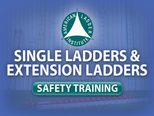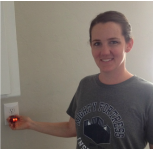1.) Hold the Rungs - Many people like to grab the sides of a ladder, however, in case of a slip, your hand strength is significantly stronger when holding the rungs. So put your hands in front, and grab the rungs!
2.) Buddy System - One of the most critical safety measures is to always have two people around when a ladder is in use. If one person falls, the other can immediately help. We have personally known several people who were hurt on ladders, and were by themselves at the time, and it took awhile for someone to come to their aid. Plus, a friend can hold the ladder still which can make ascents and descents a lot less wobbly. So, before you climb, find a friend!
3.) Angles - Another common mistake is to put the base of an extension ladder too close to the wall. A general rule of thumb is to create a 4-1 ratio, so if you have a 16 ft ladder, it shouldn't be any closer than 4 ft at the base. A 12ft ladder should have the base no closer than 3ft.
4.) No over-reaching! - It's tempting to just stretch a little, but even being just slightly off center can cause you or the ladder to fall sideways. Just say no, to over-reaching!
5.) Pre-Climb Check - Although it may sound silly, it is critical to check your equipment before using it. Make sure the legs are locked into place, make sure all the parts (like stabilizing bars) are appropriately attached, and make sure the surroundings are conducive to safety before you start to climb. An ounce of prevention is worth thousands in saved medical bills!
This post may seem a tad lengthy, but we are really just scratching the surface of ladder safety. For even more info, there is actually an American Ladder Institute! Check them out: https://www.laddersafetytraining.org/
2.) Buddy System - One of the most critical safety measures is to always have two people around when a ladder is in use. If one person falls, the other can immediately help. We have personally known several people who were hurt on ladders, and were by themselves at the time, and it took awhile for someone to come to their aid. Plus, a friend can hold the ladder still which can make ascents and descents a lot less wobbly. So, before you climb, find a friend!
3.) Angles - Another common mistake is to put the base of an extension ladder too close to the wall. A general rule of thumb is to create a 4-1 ratio, so if you have a 16 ft ladder, it shouldn't be any closer than 4 ft at the base. A 12ft ladder should have the base no closer than 3ft.
4.) No over-reaching! - It's tempting to just stretch a little, but even being just slightly off center can cause you or the ladder to fall sideways. Just say no, to over-reaching!
5.) Pre-Climb Check - Although it may sound silly, it is critical to check your equipment before using it. Make sure the legs are locked into place, make sure all the parts (like stabilizing bars) are appropriately attached, and make sure the surroundings are conducive to safety before you start to climb. An ounce of prevention is worth thousands in saved medical bills!
This post may seem a tad lengthy, but we are really just scratching the surface of ladder safety. For even more info, there is actually an American Ladder Institute! Check them out: https://www.laddersafetytraining.org/


 RSS Feed
RSS Feed